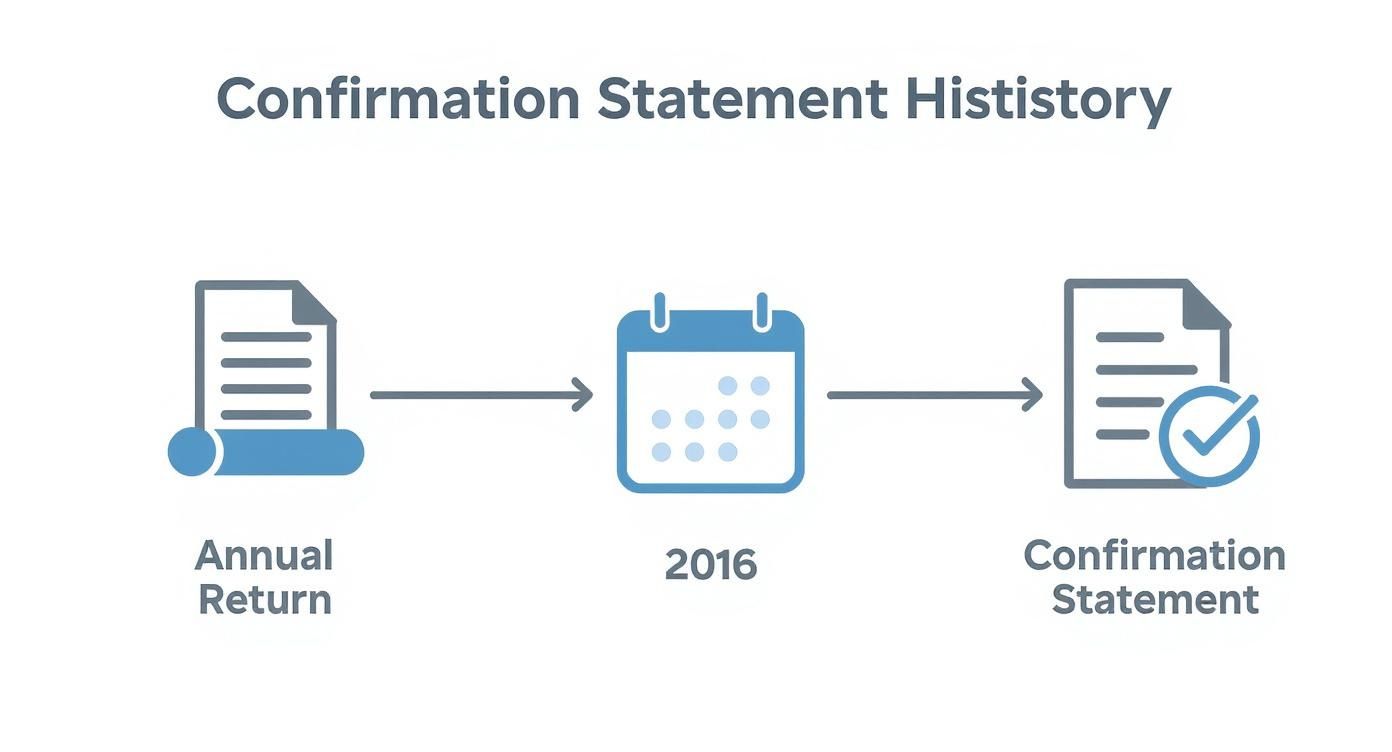Virtual Address for Business UK Your Complete Guide
Companies House Confirmation Statement – If you run a limited company or LLP in the UK, you’ll quickly become familiar with the confirmation statement. It’s a mandatory annual filing you must submit to Companies House, but it often gets confused with company accounts. They aren’t the same thing at all.
So, what exactly is it? Think of it as your company’s yearly check-in, a simple process to confirm that all the non-financial information held on the public record is correct and up-to-date. It’s all about transparency and legal compliance.
What Is a Companies House Confirmation Statement?

Imagine your company’s official profile on the Companies House register is like its passport. Over the course of a year, lots of details can change. A director might move house, you could change your company’s principal business activity, or you might issue new shares.
The confirmation statement is the official process of reviewing this “passport” and either confirming everything is still spot on or updating the details to reflect any changes that have happened.
Its main purpose is to keep the UK’s corporate register accurate and reliable. By making sure your company’s information is current, you provide a trustworthy resource for clients, suppliers, and lenders who might look you up. This simple act of verification isn’t just good practice; it’s a fundamental legal duty for every company director.
The Annual Snapshot Analogy
Here’s a practical way to think about the difference between your accounts and your confirmation statement. Your annual accounts tell the financial story of your business over the past 12 months, detailing profits, losses, and assets.
The confirmation statement, on the other hand, is like a static photograph taken on one specific day—your “confirmation date.”
The statement simply captures and verifies key administrative details at one moment in time. Its goal isn’t to report on performance but to ensure the foundational data about your company’s structure and management is accurate on the public record.
This distinction is crucial. You aren’t reporting on a year’s worth of activity; you’re just confirming the state of play on a single date. For example, if you appoint a new director the day after filing your statement, that change will be reported in the next year’s confirmation statement.
To give you a quick overview, here are the core components of the confirmation statement.
Confirmation Statement at a Glance
| Aspect | Description |
|---|---|
| Purpose | To confirm that the company’s non-financial information on the public register is correct. |
| Who Files? | All UK limited companies and LLPs, including dormant and non-trading ones. |
| Frequency | At least once every 12 months. |
| Content | Verifies details like registered office, directors, PSCs, SIC codes, and share capital. |
| Filing Fee | £13 if filed online, £40 if filed by post. |
| Financial Info | Does not contain any financial data like turnover or profit. |
Filing this document is a non-negotiable part of running a limited company in the UK. Even if your company is dormant or there have been no changes at all in the past year, you still have to file a statement to officially confirm that fact. It’s a small task, but a vital one.
Key Information You Need to Check and Confirm
Think of filing your confirmation statement like a pilot’s pre-flight checklist. It’s your annual chance to review all the information Companies House holds on your company and confirm it’s 100% correct. Getting this right now saves a world of headaches later.
Your first port of call is the registered office address. This is your company’s official, legal home and it must be a physical address in the UK – a PO Box won’t cut it. Actionable insight: Before you start your filing, double-check that this address is correct on the register. If it has changed, you must file a Form AD01 before submitting your confirmation statement. For a deeper dive into why this address is so important, check out our guide on what is a registered office.
Next up are your company officers. This means taking a close look at the details for all your directors and the company secretary (if you have one). You need to make sure their names, correspondence addresses, and other recorded details are all up to date.
Core Company Details to Verify
The checklist doesn’t stop with people and places. You also have to verify a few other structural details to ensure the public record accurately reflects your business as it stands today.
You’ll need to confirm:
- Standard Industrial Classification (SIC) code: This five-digit code tells everyone what your business actually does. Practical example: A coffee shop that starts offering catering services might need to add a second SIC code to reflect this new revenue stream. If you’ve pivoted or changed your main business activities, this code needs to be updated.
- Statement of Capital: If your company has shares, you must confirm the total number of shares, their combined nominal value, and the specifics for each class of share. Any changes, like issuing new shares to an investor, must be properly recorded here.
- Shareholder Information: You need to confirm the details of any shareholder who owned at least 5% of the company’s shares at any point during the year under review.
People with Significant Control (PSC)
A really crucial part of this process is checking your Register of People with Significant Control (PSC). A PSC is anyone who ultimately owns or controls your company. This could be someone who holds more than 25% of the shares or voting rights, or has the power to appoint or remove most of the board.
Actionable insight: Don’t just check the names. Verify the ‘nature of control’ is still accurate. For instance, if a shareholder’s stake increases from 20% to 30%, their status as a PSC has changed and must be updated. Failing to keep an accurate PSC register is a serious compliance issue, so give this step the attention it deserves.
At the end of the day, the confirmation statement is a critical yearly filing that took the place of the old annual return back in 2016. Its entire purpose is to make sure your company’s key details on the public record are accurate. This structured annual check keeps your company transparent and, most importantly, compliant.
Understanding Your Filing Deadlines And Review Period
When it comes to keeping your company compliant, timing is everything. The confirmation statement is no different. The best way to think about your company’s filing schedule is as a simple annual cycle, driven by your review period.
So, what’s a review period? It’s the 12-month timeframe that your confirmation statement covers. Your very first one kicks off on the day your company is incorporated and runs for exactly one year. From then on, each new review period begins the day after the previous one ends, creating a predictable rhythm for your compliance tasks.
The infographic below shows how we got here, moving from the old-school Annual Return to the much simpler confirmation statement we use today.

As you can see, the big shift happened in 2016. The process was modernised to focus on simply confirming existing data is still correct, rather than having to resubmit everything from scratch each year. A welcome change for business owners!
Calculating Your Due Date
Once your 12-month review period is over, a crucial filing window opens up. You have exactly 14 days to get your confirmation statement submitted to Companies House. Don’t let that short timeframe fool you – missing this deadline can lead to serious consequences, even though there aren’t any automatic late filing fees.
Let’s run through a practical example to make it crystal clear:
- Your company is incorporated on: 10th May 2024
- Your first review period ends on: 9th May 2025
- Your filing deadline is: 23rd May 2025
That 14-day window gives you just enough time to double-check your details and file the statement. Your next review period then starts right away on 10th May 2025, keeping the annual cycle ticking along smoothly.
Actionable insight: Set a calendar reminder for both your review period end date and your filing deadline. Companies House sends email reminders, but having your own system ensures you never miss the 14-day window. You can actually submit your statement at any point during the 12 months. Doing so simply resets the clock, and your next 12-month period starts from that new date.
Why Would Anyone File More Than Once A Year?
You’re only legally required to file once a year, so why would a company choose to do it more often? It’s all about keeping the public record up to date to reflect significant changes in a timely manner.
Practical example: Imagine your company issues a new block of shares to an investor in July. Your normal filing date isn’t until next May. To reassure the investor and ensure the public record is immediately accurate, you can file an early confirmation statement. This gets the new share structure officially logged, which is vital for building trust with lenders, partners, or customers who check your company’s details on the Companies House website. It costs the same £13 fee and simply resets your 12-month review period.
How to File Your Confirmation Statement Online

Thankfully, filing your confirmation statement is no longer the paper-heavy chore it once was. The overwhelming majority of businesses now use the Companies House WebFiling service, a straightforward online system designed to make compliance faster, easier, and cheaper. It’s the most popular method for good reason.
The process itself is designed to be pretty intuitive, guiding you through each stage. Before you start, you’ll need two key things: your company registration number (CRN) and your six-digit authentication code. Think of this code as your company’s secure digital signature, so keep it safe and sound.
Once you’re logged in, the system will show you all the information currently held on record for your company. Your job is simply to go through this pre-filled data with a fine-tooth comb, checking everything from your registered office to shareholder details, and flagging any changes that need to be made.
The Online Filing Process Step-by-Step
Navigating the WebFiling service is a simple, step-by-step affair. You’ll be prompted to check specific sections of your company’s information one by one. If it’s all correct, you just need to confirm it and move on.
Here’s a practical rundown of what to expect:
- Log In Securely: Head over to the Companies House online service and enter your company number and authentication code.
- Review the Summary: The first thing you’ll see is a snapshot of your company’s current details. Double-check this screen for any obvious errors before diving in.
- Confirm or Update Sections: The service will then walk you through confirming your SIC code, statement of capital, and shareholder information. You can make direct changes to these areas right there and then.
- Make Your Final Declaration: After checking everything, you’ll make a final declaration, confirming that all the information is correct as of your review period’s end date.
- Submit and Pay: The last step is to pay the filing fee, which is significantly lower online than if you were to file by post. You will receive an email confirmation once it’s been accepted.
One crucial point to remember: some changes can’t be made within the confirmation statement itself. Actionable insight: Always handle changes to directors’ personal details (form CH01) or your registered office address (form AD01) before you start the confirmation statement process. The statement is for confirming the record, not reporting every type of change.
Online vs Paper Filing
While you technically can still file a paper Form CS01 by post, the digital route is overwhelmingly the way to go. The numbers speak for themselves. In the 2024-2025 period, around 97% of the nearly 4 million confirmation statements filed were done electronically.
To put it in perspective, here’s a quick comparison of the two methods.
Online vs Paper Filing Comparison
| Feature | Online Filing (WebFiling) | Paper Filing (Form CS01) |
|---|---|---|
| Cost | £34 | £62 |
| Speed | Instant acceptance | Can take several days to be processed |
| Process | Guided, pre-filled data, fewer errors | Manual completion, higher risk of rejection |
| Convenience | File anytime, anywhere | Requires printing and postage |
For most businesses, the choice between online and paper filing is a no-brainer. If you’re looking for an efficient and affordable way to stay compliant, the WebFiling service is the obvious path.
However, if you find the process a bit daunting or simply don’t have the time, our team offers a completely hassle-free confirmation statement filing service to handle everything for you.
The Real Consequences of a Late Filing

It’s easy to think of the confirmation statement as just another bit of annual paperwork. But ignoring it is a serious mistake. Unlike missing your company accounts deadline, there isn’t an instant financial penalty for a late confirmation statement. The consequences, however, can be much, much worse.
If you sail past the 14-day filing window, Companies House won’t stay quiet for long. First, you’ll get reminder letters sent to your company’s registered office. If those are ignored, things escalate quickly.
Failing to file your confirmation statement is actually a criminal offence. This isn’t just a slap on the wrist. Both the company and its directors can be prosecuted, leading to personal fines handed down in the criminal courts. It’s a real risk that highlights just how seriously this piece of compliance is taken.
The Escalation Process
If a company continues to ignore its filing duties, Companies House makes a simple assumption: the company has stopped trading. This kicks off a formal process to have your company struck off the register and completely dissolved.
Here’s how that typically plays out:
- First Gazette Notice: A public notice is published in The Gazette, announcing the intention to strike off your company. This gives anyone with an interest in your company (like creditors) a two-month window to object.
- Dissolution: If nobody objects, your company is dissolved. It legally ceases to exist. That means it can no longer trade, pay its bills, or sell any assets.
This isn’t just closing down the business; it’s the legal termination of your company, and the fallout for directors and shareholders can be catastrophic.
Once a company is dissolved, any assets it still holds—including all the money in its bank accounts—are instantly frozen. These assets are then declared ‘bona vacantia’ (meaning ‘ownerless goods’) and legally pass to the Crown.
The Ultimate Price of Non-Compliance
That phrase, bona vacantia, is the final, jaw-dropping consequence of failing to file. Practical example: A small consulting firm with £25,000 in its business bank account fails to file its confirmation statement for over a year. Despite reminders, the director assumes it’s not important. The company is struck off, and that £25,000 is immediately seized by the Crown.
This isn’t a rare occurrence; it’s the standard legal procedure. Trying to get that money back is an expensive, complicated, and painfully slow process that involves restoring the company to the register—and even then, there’s no guarantee of success. The message from Companies House couldn’t be clearer: staying on top of your filing is the only way to protect your business and its assets.
Navigating Upcoming Changes to Companies House Rules
The landscape of UK corporate compliance is on the cusp of a major shake-up. For years, Companies House has acted more like a passive library, simply storing the information businesses submitted. That’s all changing. It’s now stepping into a new role as an active gatekeeper, armed with fresh powers to ensure the integrity of the company register.
This isn’t just bureaucratic tinkering. It’s part of a much wider government crackdown on economic crime. The core mission is to make sure the people behind UK companies are exactly who they claim to be, making the register a far more reliable resource for everyone.
A New Era of Scrutiny and Verification
These sweeping changes are being introduced through the Economic Crime and Corporate Transparency Act. From 2024 right through to 2026, Companies House is rolling out reforms that will fundamentally alter how company data is handled. As of March 2024, it already has beefed-up powers to challenge and even remove dodgy information from its records.
But the biggest change is still on the horizon: mandatory identity verification for all company directors and Persons with Significant Control (PSCs). This is a genuine game-changer, designed to slam the door on fraudulent appointments and dramatically boost the accuracy of the public record.
What Identity Verification Means for You
So, what does this look like in practice? Before a director or PSC can be appointed or even file key documents like the confirmation statement, they will have to prove their identity through a government-approved digital system.
It’s expected to be a one-time process, likely involving an app or an online portal where you confirm who you are using official documents.
Actionable insight: Get ahead of the curve. Ensure all your directors and PSCs have readily available, up-to-date photo ID (like a passport or driving licence). While the system isn’t live yet, being prepared will prevent delays when these checks become mandatory.
These new rules also mean that any changes to key details, like your official company address, will need careful handling. For guidance on this, our article on how to manage a Companies House change of registered address provides essential steps to follow. Preparing for these new standards now will ensure a smooth transition for your business.
Frequently Asked Questions
Even when the process seems straightforward, there are always a few lingering questions that pop up. Let’s tackle some of the most common queries business owners have about the confirmation statement, so you can file with complete confidence.
Confirmation Statement vs Annual Return: What’s the Difference?
This is a classic point of confusion, especially for anyone who’s been running a company since before 2016. The short answer is that the confirmation statement replaced the old annual return on 30th June 2016. While they both do a similar job—keeping the public record up to date—they work in very different ways.
- The Old Way (Annual Return): This was a chore. Every year, you had to fill out a form from scratch, re-entering every single detail about your company, even if absolutely nothing had changed. It was repetitive and a major time-drain.
- The New Way (Confirmation Statement): Thankfully, the modern system is much smarter. Companies House shows you the information they already have on file for your company. All you have to do is confirm it’s still correct. You only need to report the changes, not the whole lot.
The switch was a common-sense move to cut down on admin headaches and make life easier for millions of UK business owners.
Can My Accountant File My Confirmation Statement for Me?
Yes, they certainly can! It’s incredibly common for business owners to hand this task over to a trusted third party, like an accountant or a company formation agent. They handle these filings day in and day out, ensuring everything is done correctly and on time, which frees you up to run your business.
To let them file on your behalf, you’ll need to give them your company’s unique six-digit authentication code. Actionable insight: Treat this code like a bank PIN. Only share it with trusted professionals you have authorised to act on your behalf, and consider changing it if an advisor no longer works with you.
What if I Spot a Mistake After Filing?
Don’t panic! Finding a mistake after you’ve already hit ‘submit’ is more common than you think, and it’s usually easy to fix. If you notice an error on the public record, you can correct it by filing a second confirmation statement using Form RP04.
Practical example: You filed your statement but later realised you forgot to update the details for a shareholder who sold their shares three months ago. You can use Form RP04 to submit a new statement of capital and shareholder list, correcting the record. The good news is there’s no extra fee for this. The key is to act quickly to ensure the public record is accurate.
Companies House wants the register to be accurate, so they’ve made it simple to correct genuine errors. Just take the steps to put it right as soon as you spot the problem.
Juggling compliance deadlines while trying to grow a business is a tough act. Acorn Business Solutions offers a reliable Confirmation Statement Filing Service, making sure your company stays compliant without the stress. Let our experts handle the paperwork so you can get back to what you do best.






